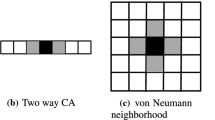Abstract
In this article the dynamical behaviour of asynchronous cellular automata (CA) is formally studied. Classical CA properties as surjectivity, injectivity, sensitivity, expansivity, transitivity, dense periodic orbits and equicontinuity have been adapted to the asynchronous case. We also deal with stability of properties with respect to perturbations on some update sequences which produce a significant dynamical behaviour.
Similar content being viewed by others
References
Acerbi L, Dennunzio A, Formenti E (2007) Shifting and lifting of cellular automata. In: CiE, LNCS, vol 4497. Springer, Berlin, pp 1–10
Acerbi L, Dennunzio A, Formenti E (2009) Conservation of some dynamical properties for operations on cellular automata. Theor Comput Sci 410:3685–3693
Amar P, Bernot G, Norris V (2004) Hsim: a simulation programme to study large assemblies of proteins. J Biol Phys Chem 4:79–84
Bersini H, Detours V (1994) Asynchrony induces stability in cellular automata based models. In: Proc. of artificial life IV. MIT Press, Cambridge, pp 382–387
Buvel R, Ingerson T (1984) Structure in asynchronous cellular automata. Physica D 1:59–68
Cattaneo G, Dennunzio A, Margara L (2002) Chaotic subshifts and related languages applications to one-dimensional cellular automata. Fundam Inf 52:39–80
Cattaneo G, Dennunzio A, Margara L (2004) Solution of some conjectures about topological properties of linear cellular automata. Theor Comput Sci 325(2):249–271
Cattaneo G, Dennunzio A, Formenti E, Provillard J (2009) Non-uniform cellular automata. In: LATA, LNCS, vol 5457. Springer, Berlin, pp 302–313
Chaudhuri P, Chowdhury D, Nandi S, Chattopadhyay S (1997) Additive cellular automata theory and applications, vol 1. IEEE Press, New York
Chopard B (2010) Modelling physical systems by cellular automata. In: Rozenberg G et al (eds) Handbook of natural computing: theory, experiments, and applications. Springer, Heidelberg
Dennunzio A, Formenti E (2008) Decidable properties of 2d cellular automata. In: Developments in language theory. LNCS, vol 5257. Springer, Berlin, pp 264–275
Dennunzio A, Di Lena P, Formenti E, Margara L (2009) On the directional dynamics of additive cellular automata. Theor Comput Sci 410:4823–4833
Dennunzio A, Masson B, Guillon P (2009) Sand automata as cellular automata. Theor Comput Sci 410:3962–3974
Dennunzio A, Formenti E, Kůrka P (2010) Cellular automata dynamical systems. In: Rozenberg G et al (eds) Handbook of natural computing: theory, experiments, and applications. Springer, Heidelberg
Farina F, Dennunzio A (2008) A predator–prey cellular automaton with parasitic interactions and environmental effects. Fundam Inf 83:337–353
Fatès N, Morvan M (2005) An experimental study of robustness to asynchronism for elementary cellular automata. Complex Syst 16(1):1–27
Fatès N, Morvan M, Schabanel N, Thierry E (2006a) Fully asynchronous behaviour of double-quiescent elementary cellular automata. Theor Comput Sci 362:1–16
Fatès N, Regnault D, Schabanel N, Thierry E (2006b) Asynchronous behaviour of double-quiescent elementary cellular automata. In: Proceedings of LATIN2006, LNCS, vol 3887. Springer, Berlin, pp 455–466
Fukś H (2002) Non-deterministic density classification with diffusive probabilistic cellular automata. Phys Rev E 66(2):066106
Kůrka P (1997) Languages, equicontinuity and attractors in cellular automata. Ergod Theory Dyn Syst 17:417–433
Kůrka P (2009) Topological dynamics of one-dimensional cellular automata. In: Meyers B (ed) Mathematical basis of cellular automata, encyclopedia of complexity and system science. Springer, Berlin, pp 2232–2242
Levenshtein V (1966) Binary codes capable of correcting deletions, insertions, and reversals. Sov Phys Dokl 10(8):707–710
Maruoka A, Kimura M (1979) Injectivity and surjectivity for parallel maps for CA. J Comput Syst Sci 18:47–64
Nakamura K (1974) Asynchronous cellular automata and their computational ability. Syst Comput Control 5:58–66
Regnault D (2006) Abrupt behaviour changes in cellular automata under asynchronous dynamics. In: Electronic proc. of 2nd European conference on complex systems, ECCS, Oxford
Regnault D, Schabanel N, Thierry E (2009) Progresses in the analysis of stochastic 2D cellular automata: a study of asynchronous 2D minority. Theor Comput Sci 410:4844–4855
Schönfisch B, de Roos A (1999) Synchronous and asynchronous updating in cellular automata. BioSystems 51:123–143
Author information
Authors and Affiliations
Corresponding author
Rights and permissions
About this article
Cite this article
Manzoni, L. Asynchronous cellular automata and dynamical properties. Nat Comput 11, 269–276 (2012). https://doi.org/10.1007/s11047-012-9308-y
Published:
Issue Date:
DOI: https://doi.org/10.1007/s11047-012-9308-y




